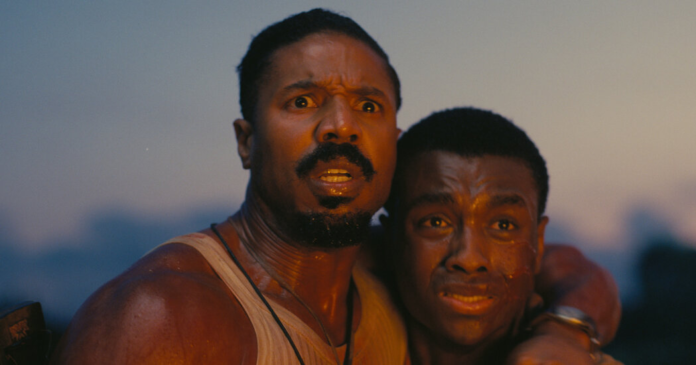Advertisement
Supported by
Anatomy of a Scene
The writer and director Ryan Coogler narrates a sequence from his film.
transcript
Hey, what’s going on. I’m Ryan Coogler, and I’m the writer-director of “Sinners.” So this is Sammie performing “I Lied to You,” which is our midpoint of the film, and it’s kind of a hero moment for him. Thi song was written by the great Raphael Saadiq and Ludwig Goransson, our composer, and Raphael is from Oakland. Kind of a local legend where I’m from. So it was an honor to have him on this. And with this, we wanted to use Michael Shawver’s editing skills to establish where everybody is and what their stakes are in the observation of this. So you see Smoke here in one corner, you see Stack, and they have a kind of an ongoing argument about how successful this night is going to be, what it’s going to take, what Sammie’s role should be in this. So, so setting up that kind of triangle Sammie with the twins between him and playing on that triangle as an idea here you got Delta Slim in a flashback giving Sammie a little bit of a context to his skill and the responsibility that comes with it and the legacy of it, and this conversation gets suspended because Wunmi Mosaku’s character Annie, who is a conjure woman, is giving her context, and she’s actually restating something that we’ve heard at the beginning of the film. She kind of gave a warning that musicians will have the capability of doing in this movie, and here we’re seeing it play out, and we’re slowly introducing these ancestor spirits, both from the past and the future. And we wanted to do it in a fluid, continuous take. Obviously, we’re shooting this here with Imax film cameras, 15 perforations per frame, 65 mm, 70 when projected. And we had to get up on that stage and kind of rotate around and really be definitive about when we introduced these ancestors and how they come in. And Ludvig, at the same time is changing the music. Aakomon Jones, our choreographer, is changing the choreography ever so slightly so that folks still feel like they’re in their time, but also outside of it as we get more and more heightened in this moment. And with this swirling feeling we wanted to give the feeling of an incredible concert and being kind of swept away and overwhelmed by the artistry.
Mekado Murphy
In “Anatomy of a Scene,” we ask directors to reveal the secrets that go into making key scenes in their movies. See new episodes in the series on Fridays. You can also watch our collection of more than 150 videos on YouTube and subscribe to our YouTube channel.
Viewers might not expect to see a DJ at a turntable in Ryan Coogler’s 1930s-set horror movie “Sinners,” but in this sequence, the history and future of music collide.
This sequence takes place in a juke joint opened by the twins Smoke and Stack (both played by Michael B. Jordan). Playing for the crowd is Sammie Moore (Miles Caton), performing a song that was written by Raphael Saadiq and the film’s composer, Ludwig Goransson.
“Rafael is from Oakland, kind of a local legend where I’m from,” Coogler said, narrating the moment.
The scene starts with Caton’s impressive vocals, while cutting to shots of both Smoke and Stack, as well as other characters in the sequence. “We wanted to use Michael Shawver’s editing skills to establish where everybody is and what their stakes are,” Coogler said.
Once all is laid out, the scene flashes back to a conversation between Sammie and another musician, Delta Slim (Delroy Lindo), who explains Sammie’s skill for the blues and the responsibility that comes with his talent.
“Blues, it wasn’t forced on us like that religion,” Delta says. “No, son. We brought this with us from home. It’s magic, what we do. It’s sacred and big.”
As the scene returns to the juke joint, we hear a voice-over from Annie (Wunmi Mosaku), a conjure woman. She says that some musicians have the gift to make music so powerful, it can conjure spirits from the past and the future. At this point, in an ambitious tracking shot, various eras of musicians appear in the frame, including an electric guitarist and the D.J. at the turntable.
“We wanted to do it in a fluid, continuous take,” Coogler said. New music elements continue to be introduced along with new forms of dance.
“Aakomon Jones, our choreographer, is changing choreography ever so slightly so that folks still feel like they’re in their time, but also outside of it as we get more and more heightened in this moment,” Coogler said.
Read the “Sinners” review.
Read an interview with Michael B. Jordan and Coogler.
Hear from Buddy Guy, a musician who appears in the post-credits sequence.
Find out about the symbolism in “Sinners.”
See how “Sinners” and other movies multiply one actor.
Sign up for the Movies Update newsletter and get a roundup of reviews, news, Critics’ Picks and more.
Mekado Murphy is the assistant film editor. He joined The Times in 2006.
Beyoncé’s Cowboy Carter Tour is a Critic’s Pick. Read our review.
“Sinners,” the blues and fighting for artistic control.
The resurrection of Rilo Kiley.
Lorde’s nostalgic breakup anthem, and 9 more new songs.
How Blondshell became an alt-rock supernova.
Advertisement
Sinners’ Director Ryan Coogler Narrates Musical Scene – The New York Times
RELATED ARTICLES
